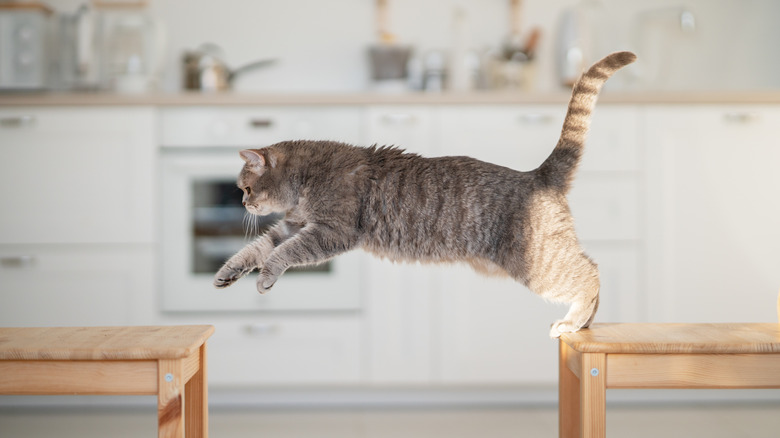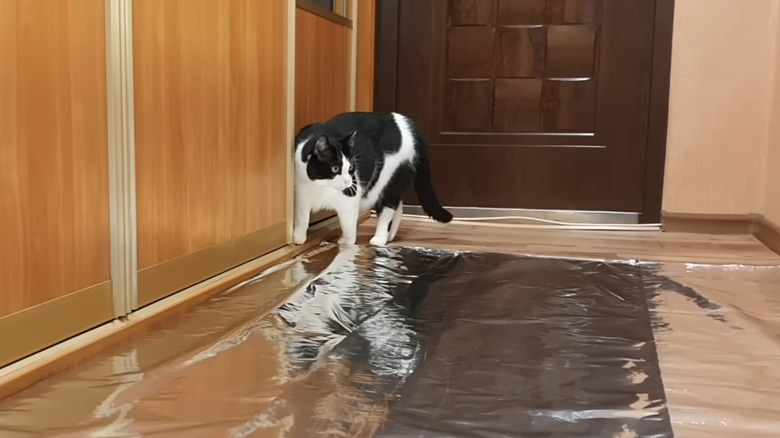Why Cats Absolutely Hate Foil
If you've ever laid down a sheet of aluminum foil and watched your cat launch into orbit like they just saw a ghost, you're not alone. As the backbone of the internet is composed of cat videos, examples of this baffling feline phenomenon are readily available on most, if not all, major social media platforms. It's absolutely true: they plain hate the stuff. While most of us are familiar with common cat behaviors like licking and meowing, the reason why something as harmless as foil sends a cat into full-blown panic mode is not as well understood.
It turns out, aluminum foil is a sensory nightmare for cats. Their ultrasonic hearing picks up on foil's high-pitched crinkling noises — frequencies beyond human perception, but painfully jarring for them. You may notice that the rustling of plastic bags elicits a similar response in some cats. Think of it as nails on a chalkboard, but worse. Then there's the tactile disaster. Cats' sensitive paw pads, packed with nerve endings, find the foil's cold, crinkly, and unstable texture deeply unpleasant. It feels unnatural and unsafe, almost like stepping onto an alien craft made of exotic material.
Visually, foil adds another layer of confusion. Since it reflects up to about 80% of visible light, it can mimic the appearance of water or a moving object, triggering a cautionary response. For a creature that relies on finely tuned senses for survival, this trifecta of auditory, tactile, and visual chaos is simply too much to handle.
Feline evolutionary instincts and foil
In addition to sensory overload, feline aversion to foil is deeply rooted in evolutionary survival mechanisms. In the wild, cats instinctively avoid unstable or unknown textures because they often signal danger. Take their fight-or-flight response, a biological system designed to keep them alive. The unpredictable noise and shifting feel of foil make it impossible to predict or control, triggering an immediate escape reflex. Additionally, foil's high-frequency crackling is eerily similar to the rustling noises made by potential prey or threats. Instead of curiosity, this auditory cue can provoke either predatory hyper-alertness or fear-based avoidance.
Let's not forget the startle reflex. Even though your indoor cat may never have had to dodge a predator — unless we're counting their arch nemesis, the vacuum cleaner — their nervous system is still hardwired for self-preservation. A sudden foil encounter can activate the same instant recoil mechanism that would help them evade a snake or unstable terrain in the wild. In other words, when your cat leaps three feet into the air, it's just their internal evolutionary wind-up toy being set in motion.
Should you use foil as a cat training tool?
Given the intense aversion to the material, some well-meaning cat parents use foil to keep cats off countertops and other surfaces. But does the aluminum foil hack for keeping pets off of furniture really work? Short-term? Absolutely. Most cats will steer clear after one or two terrifying encounters. Long-term? Not so much. Some cats habituate to the foil, learning that while it's annoying, it isn't actually dangerous. Others may develop anxiety or negative associations with specific areas, leading to stress-related behaviors like excessive hiding or avoidance.
More importantly, relying on foil doesn't teach your cat where they should go, only what to avoid. A better strategy is to provide alternative surfaces like scratching posts, cat trees, or padded window perches. Other effective deterrents include double-sided tape, motion-activated deterrents (like air sprays) to keep cats off of kitchen counters, and citrus-based repellents, which cats find unpleasant but not distressing.
If you want well-behaved pets without the dramatic parkour, positive reinforcement training is the way to go with your cats. Reward them for using their designated spaces instead of punishing their natural curiosity. If you're still tempted to go the foil route, perhaps it's best to sit back, relax, and enjoy the viral videos instead!


